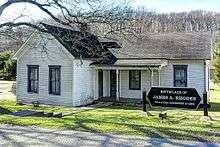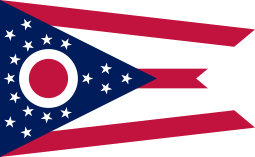Jim Rhodes
James Allen Rhodes (September 13, 1909 – March 4, 2001) was an American Republican politician from Ohio, a key figure in the 1970 Kent State shootings and as of 2019 one of only seven governors to serve four four-year terms in office. (The other six being Edwin Edwards, George Wallace, Jim Hunt, Bill Janklow, Jerry Brown, and Terry Branstad.) Rhodes is tied for the fourth longest gubernatorial tenure in post-Constitutional U.S. history at 5,840 days.[1]
Jim Rhodes | |
|---|---|
 Governor James A. Rhodes in 1981 | |
| 61st and 63rd Governor of Ohio | |
| In office January 13, 1975 – January 10, 1983 | |
| Lieutenant | Dick Celeste (1975–1979) George Voinovich (1979) Vacant (1979–1983) |
| Preceded by | John J. Gilligan |
| Succeeded by | Dick Celeste |
| In office January 14, 1963 – January 11, 1971 | |
| Lieutenant | John W. Brown |
| Preceded by | Michael DiSalle |
| Succeeded by | John J. Gilligan |
| 21st Ohio State Auditor | |
| In office 1953–1963 | |
| Governor | Frank J. Lausche John William Brown C. William O'Neill Michael DiSalle |
| Preceded by | Joseph T. Ferguson |
| Succeeded by | Roger W. Tracy, Jr. |
| 44th Mayor of Columbus | |
| In office 1944–1952 | |
| Preceded by | Floyd F. Green |
| Succeeded by | Robert T. Oestreicher |
| Personal details | |
| Born | James Allen Rhodes September 13, 1909 Coalton, Ohio, U.S. |
| Died | March 4, 2001 (aged 91) Columbus, Ohio, U.S. |
| Resting place | Green Lawn Cemetery Columbus, Ohio |
| Political party | Republican |
| Spouse(s) | Helen Rawlins |
| Education | Springfield High School |
| Alma mater | Ohio State University |
On May 3, 1970, Rhodes sent National Guard troops onto the Kent State University campus at the request of Kent, Ohio mayor LeRoy Satrom after the ROTC building was burned down by unknown arsonists the previous night. On May 4, Guardsmen gunned down unarmed students Allison Beth Krause, 19, Jeffrey Glenn Miller, 20, Sandra Lee Scheuer, 20, and William Knox Schroeder, 19, and wounded nine others, including Dean Kahler, who suffered permanent paralysis.[2]
Life and Politics

Rhodes was born in Coalton, Jackson County, Ohio, to James and Susan Howe Rhodes, who were of Welsh descent.[3] Rhodes has commented that the reason he and his family were Republicans was because of the respect his father, a mine superintendent, had for John L. Lewis, a prominent Republican union activist.[4] When Rhodes was nine his father died and the family moved to north Springfield where Rhodes graduated from Springfield High School where he played on the football team. Subsequently, the family moved again, this time to Columbus, because Rhodes earned a modest basketball scholarship to The Ohio State University. Although Rhodes dropped out after his first quarter he is often described as a "student" or "alumnus" of Ohio State.[3] After dropping out of college, Rhodes opened a business called Jim's Place across from the university on North High Street. Jim's Place has been described as a place where one could buy anything, from doughnuts and hamburgers, to Stag film, or place bets on numbers games.[5]
In 1934, Rhodes began to use his position as a local businessman to climb up the Columbus political ladder, and became a ward committeeman, a member of the Columbus school board, the city auditor, and eventually the mayor of Columbus (1944–1952). It was during this time that he married Helen Rawlins. Rhodes's time as mayor is primarily marked by two achievements, with the first being his convincing of 67% of Columbus voters to approve the city's first income tax, and the second being his successful use of water gun diplomacy to annex much of the surrounding suburbs to Columbus. As surrounding communities grew or were constructed, they came to require access to waterlines, which was under the sole control of the municipal water system. Rhodes told these communities that if they wanted water, they would have to submit to assimilation into Columbus. As a result of this, Columbus, Ohio, currently has the largest land area of any Ohio city.[6]
With an eye on the governorship, Rhodes was elected State Auditor in 1952, and took office in early 1953. In 1954, Rhodes ran against the popular incumbent, Democratic governor Frank Lausche, and lost by a 54% to 46% margin. In 1962, Rhodes ran again for governor – this time against Democratic incumbent Mike DiSalle. Rhodes's campaign centered on "jobs and progress," and in speeches Rhodes routinely claimed that an increase in jobs would lead to a decrease in everything from crime and divorce, to mental illness.[7] Rhodes also made DiSalle's tax increases, such as the gas tax, a prominent part of his campaign. Rhodes also weathered a minor scandal when Democratic State Chairman alleged that Rhodes diverted and borrowed a total of $54,000 from his campaign funds.[8] During a debate, both Rhodes and DiSalle agreed that this was, "the most vicious campaign [of] the Ohio governorship."[3] On November 6, 1962, Ohioans voted Rhodes into the governorship with 59% of the vote.[3]

Rhodes served two terms as governor, and he also was a "favorite son" Presidential candidate who controlled the Ohio delegation to the Republican National Conventions in 1964 and 1968, before retiring in 1971. He ran for the U.S. Senate in 1970 and narrowly lost, to U.S. Representative Robert Taft, Jr., in the primary election, which was two days after the events at Kent State.
Rhodes oversaw the last two (by electrocution) pre-Furman executions in Ohio,[9] which were both in early 1963, before Ohio resumed executions in 1999. In 1983 Rhodes pardoned boxing promoter Don King for a 1967 non‐negligent manslaughter conviction of stomping one of his employees to death.
At a news conference in Kent, Ohio, on Sunday May 3, 1970, the day before the Kent State shootings, he said of campus protesters:
They're worse than the Brownshirts, and the Communist element, and also the Night Riders, and the vigilantes. They're the worst type of people that we harbor in America.[10]
Since the Ohio Constitution limits the governor to two four-year terms, when Rhodes initially filed to run again in 1974, his petitions were refused by the Secretary of State. Rhodes sued, and the Ohio Supreme Court ruled that the limitation was on consecutive terms, thus freeing him to return to office by narrowly defeating incumbent John Gilligan in an upset in the 1974 election. He served two more terms before retiring again in 1983. During the energy crisis of the winter of 1976–77, Rhodes led a 15-minute service, in which he "beseech[ed] God to relieve the storm."[11] The next year, January 1978, amid a blizzard which dropped 31 inches of snow onto Ohio and killed 60 people in the Northeast, Rhodes called the storm "the greatest disaster in Ohio history."[11]
On August 16, 1977 Rhodes was hit in the face and shoulder with a banana cream pie thrown by Steve Conliff, as about 25 young people disrupted the opening of the Ohio State Fair. Conliff then ran unsuccessfully against Rhodes for the Republican nomination.
Rhodes ran for the governorship again in 1986, seeking a record-breaking fifth term, but soundly lost to the incumbent Dick Celeste, whom Rhodes had narrowly defeated in his last successful gubernatorial bid in 1978.
Rhodes died in Columbus on March 4, 2001, and is interred at Green Lawn Cemetery, Columbus, Ohio.
Literary
Rhodes co-authored stories of historical fiction with Dean Jauchius, including The Trial of Mary Todd Lincoln, The Court-Martial of Oliver Hazard Perry and Johnny Shiloh, a novel of the Civil War.[12] The last was adapted to a 1963 television movie by Walt Disney, also called Johnny Shiloh, for which Rhodes received writer's credit.
Legacy
Numerous buildings and sites around the state have been named in Rhodes's honor, including:
- The James A. Rhodes State Office Tower – the tallest building in Columbus and the former home of the Ohio Supreme Court
- Cleveland State University's Rhodes Tower in Cleveland
- The James A. Rhodes Arena (locally nicknamed as "The JAR") at the University of Akron
- James A. Rhodes State College in Lima, Ohio.
- The Rhodes Center at the Ohio Expo Center and State Fair in Columbus
- The James A. Rhodes Appalachian Highway, Ohio State Route 32
- The James A. Rhodes Athletic Center, Shawnee State University
Electoral History
1962 Election
Jim Rhodes won the gubernatorial election, defeating sitting Governor Michael DiSalle 58.92% to 41.08%.
1966 Election
Jim Rhodes won a second term, defeating Frazier Reams Jr. 62.18% to 37.82%
1974 Election
Jim Rhodes won a third term, defeating sitting Governor John J. Gilligan 48.62% to 48.25%.
1978 Election
Jim Rhodes won a fourth term, defeating Dick Celeste 49.31% to 47.64%.
See also
- Statue of Jim Rhodes (1982)
Notes
- Ostermeier, Eric (April 10, 2013). "The Top 50 Longest-Serving Governors of All Time". Smart Politics.
- Dean Kahler: Visitors' Center helps him move past May 4, 1970 'Dean Kahler, among the most severely wounded of the 13 Kent State students shot by the National Guard on May 4, 1970, tours the new May 4th Visitors' Center being dedicated this weekend' WKSU, May 3, 2013. Retrieved January 25, 2014.
- Zimmerman, p. 85-108.
- Zimmerman, p. 86.
- Zimmerman, p. 86, 87.
- Zimmerman, p. 87.
- Zimmerman, p. 92.
- Zimmerman, p. 93.
- "Ohio Executions". Archived from the original on February 23, 2008. Retrieved April 14, 2008. The History Of Executions in America Before Lethal Injection. Retrieved from Internet Archive 25 January 2014.
- Bills, Shirley; Bills, Scott L. (1988), "Scott L. Bills", in Scott L. Bills (ed.), Kent State/May 4: Echoes Through a Decade, Kent, Ohio: The Kent State University Press, p. 13, ISBN 978-0-87338-360-8
- Frum, David (2000), How We Got Here: The '70s, New York, New York: Basic Books, p. 322, ISBN 0-465-04195-7
- "Rhodes, James A. (James Allen) 1909–2001". OCLC WorldCat Identities.
References
- Zimmerman, Richard Z. (2007), Lamis, Alexander P.; Usher, Brian (eds.), Ohio Politics: Revised and Updated, Kent, Ohio: The Kent State University Press, pp. 85–108, ISBN 978-0-87338-613-5
- Diemer, Tom; Leonard, Lee; Zimmerman, Richard (2014). James A. Rhodes, Ohio Colossus. Kent State University Press. ISBN 978-1606352151.
External links
| Wikiquote has quotations related to: Jim Rhodes |
| Wikimedia Commons has media related to Jim Rhodes. |
- James A. Rhodes at Ohio History Central
- Jim Rhodes at Find a Grave
- Jim Rhodes at Political Graveyard
- Ohio Expo Center
- Ohio State Fair



